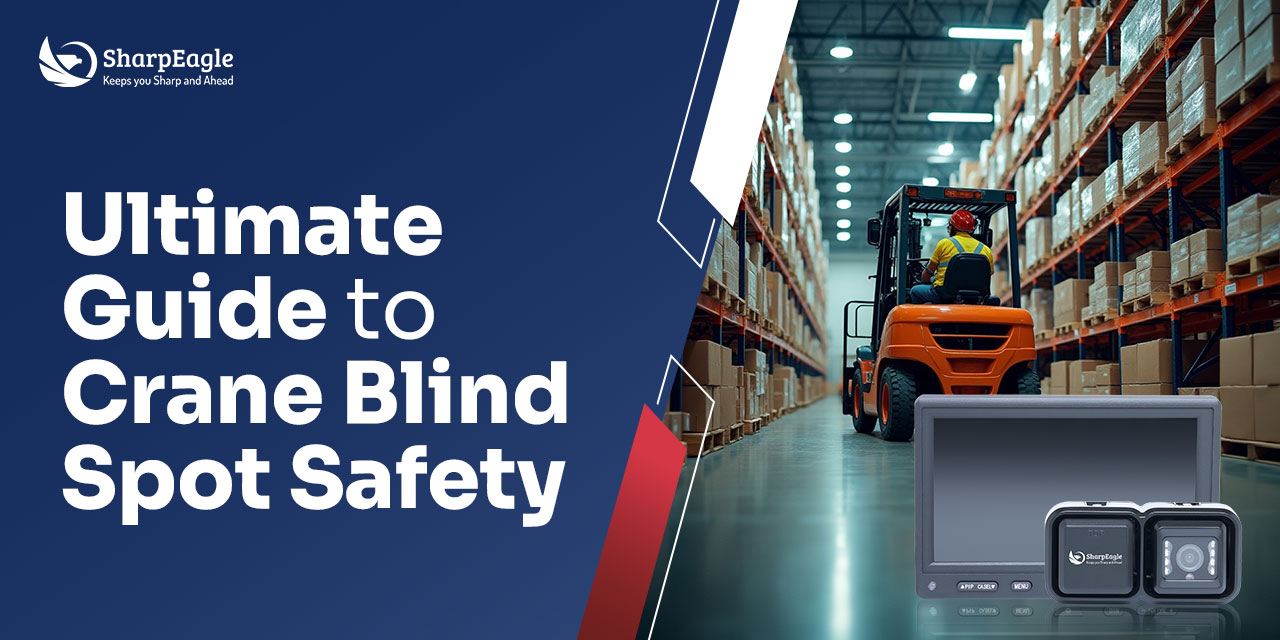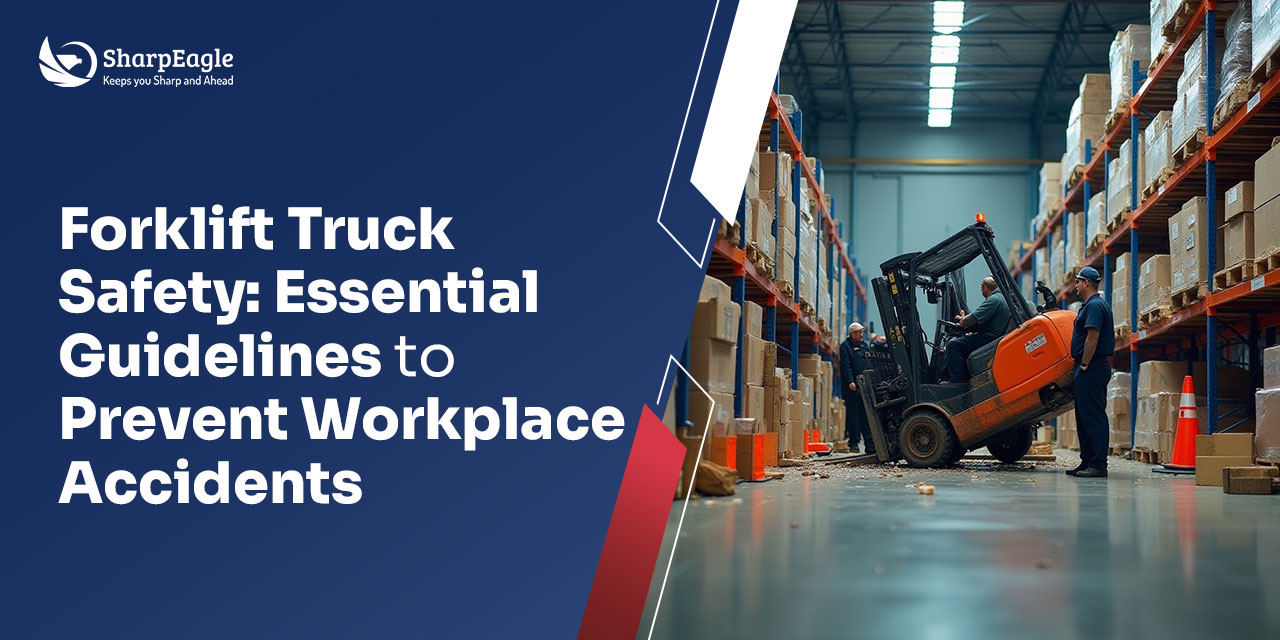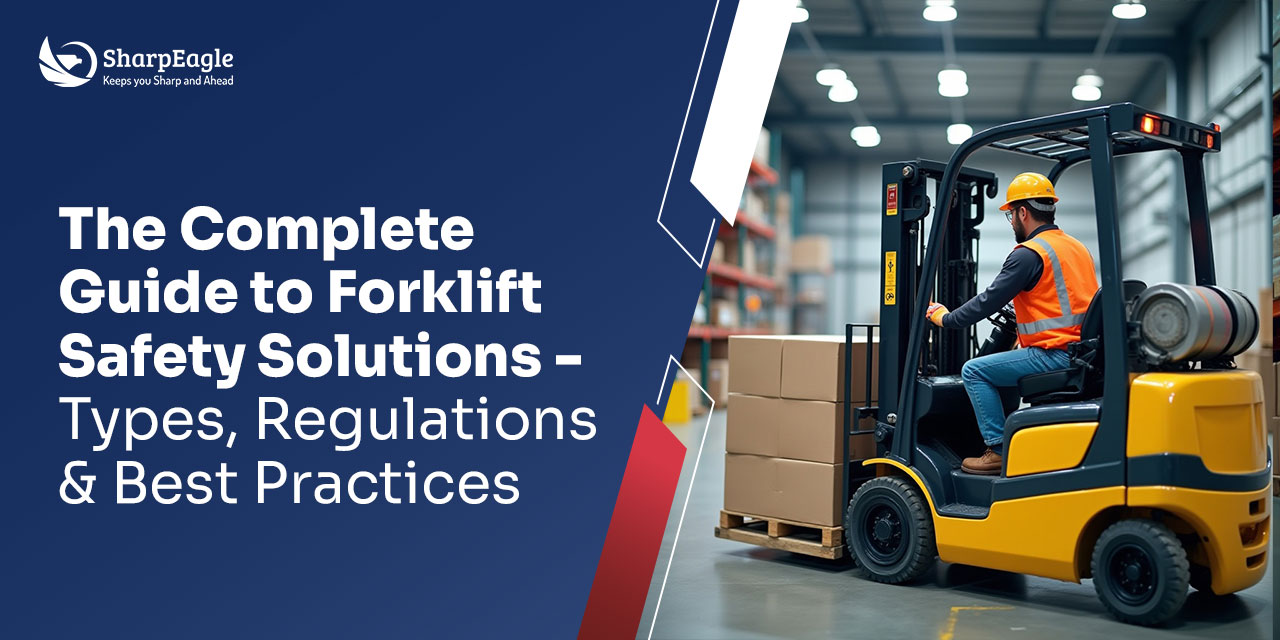

Picture this: It's 2 AM in a Manchester warehouse, and visibility is at its lowest. A forklift operator, battling fatigue after six hours on shift, navigates narrow aisles while handling valuable inventory. This scenario plays out thousands of times nightly across UK facilities, where night-shift operations face 40% higher accident risks compared to daytime operations. The combination of human fatigue and inadequate lighting creates a perfect storm for costly errors, equipment damage, and worker injuries.
The financial impact is staggering - UK warehouses report average accident costs of £15,000-50,000 per incident, with night-shift incidents typically resulting in higher severity and costs. Traditional warehouse lighting often falls short during overnight operations, leaving dangerous blind spots and insufficient visibility for safe forklift operations. However, innovative smart forklift lighting UK solutions are transforming night-shift safety standards, offering advanced LED technology, intelligent sensors, and visibility-enhancing systems that dramatically reduce errors while improving operational efficiency and worker confidence.
Understanding the unique risks associated with overnight warehouse operations helps explain why specialized lighting solutions have become essential for maintaining safety standards and operational efficiency.
Night-shift forklift operations in UK facilities face a complex array of risk factors that significantly increase accident probability. Research from the Health and Safety Executive indicates that workplace accidents increase by 15-20% during night hours, with forklift-related incidents showing even higher spikes. Operator fatigue becomes a critical factor after midnight, when natural circadian rhythms cause alertness to decline sharply.
Key Night-Shift Risk Factors:

Limited visibility creates particularly dangerous conditions when forklifts operate near pedestrian walkways, loading docks, and intersections. The warehouse safety UK guidelines emphasize that inadequate lighting contributes to approximately 60% of night-shift material handling accidents, making proper illumination a critical safety requirement rather than an optional upgrade.
The financial consequences of night-shift errors extend far beyond immediate accident costs, creating ripple effects that impact overall facility profitability and operational efficiency.
Equipment downtime from accidents during night shifts typically lasts 25-40% longer than daytime incidents due to limited maintenance support and parts availability. Injury claims arising from night-shift accidents average £25,000-75,000 in the UK, significantly higher than daytime incidents due to increased severity and complexity of injuries sustained in low-visibility conditions.
Productivity losses compound the direct costs, with night shift forklift operations UK experiencing 20-35% slower throughput when operators lack confidence in visibility conditions. This reduced efficiency translates to delayed shipments, overtime costs, and customer satisfaction issues that can impact long-term business relationships.
HSE forklift safety UK regulations specifically address lighting requirements for workplace safety, with particular emphasis on night-shift operations and adequate visibility standards.
The Health and Safety Executive's guidance on workplace lighting specifies minimum illumination levels for different industrial activities, with forklift operations requiring enhanced lighting standards due to their inherent risks. Current regulations mandate that employers provide "adequate and suitable lighting" for all work activities, with specific requirements for areas where vehicles and pedestrians interact.
Recent HSE enforcement actions have increasingly focused on lighting adequacy, with several UK warehouses receiving improvement notices for insufficient night-shift lighting provision. Compliance requirements now extend beyond basic illumination to include emergency lighting, backup systems, and specialized task lighting for complex operations.
Modern lighting technology offers comprehensive solutions that address the specific challenges of night-shift warehouse operations while providing measurable improvements in safety and efficiency.
Advanced LED spotlight technology forms the foundation of effective smart forklift lighting UK systems, providing superior illumination while offering energy efficiency and longevity benefits.
The Forklift Blue Spot Light UK systems project bright blue LED spots ahead of and behind forklifts, creating clear visual warnings for pedestrians and other equipment operators. These systems typically project light patterns 3-5 meters from the vehicle, providing advance warning in high-traffic areas where visibility is critical.
Forklift Red Danger Light UK installations complement blue spotlights by indicating hazardous conditions or equipment malfunctions. Red warning lights activate during reverse operations, load lifting, or when sensors detect potential collision risks. The combination of blue and red lighting creates a comprehensive visual communication system that significantly enhances night-shift safety.
LED Spotlight Advantages:
Forklift Arc Safety Light UK systems represent the cutting edge of visibility enhancement, projecting clear geometric patterns that define safe operating zones around moving equipment.
These systems project bright LED arcs, circles, or lines onto warehouse floors, creating highly visible safety boundaries that move with the forklift. The projected patterns help pedestrians maintain safe distances while providing operators with clear visual references for navigation and positioning.
Forklift Laser Light UK technology offers precision projection capabilities that create sharp, clearly defined boundaries even on textured or uneven warehouse floors. Laser systems can project custom patterns including company logos, directional arrows, or specific warning symbols that enhance communication effectiveness.
Projection Light Benefits:
Intelligent lighting systems represent the future of warehouse illumination, automatically adjusting output based on environmental conditions and operational requirements.
Motion-activated systems detect approaching pedestrians or equipment, automatically increasing illumination levels in specific areas. These systems reduce energy consumption during low-activity periods while ensuring optimal visibility when needed most.
Ambient light sensors automatically adjust LED forklift lights UK output based on existing lighting conditions, maintaining optimal visibility without creating glare or excessive brightness that could impair operator vision.
Smart System Features:
The implementation of advanced lighting systems addresses multiple failure points that contribute to night-shift accidents while improving overall operational performance.
Comprehensive lighting solutions eliminate dangerous blind spots that contribute to the majority of night-shift forklift accidents in UK facilities.
Smart forklift lighting systems provide 360-degree visibility enhancement, ensuring operators can clearly see pedestrians, obstacles, and other equipment from all angles. The forklift visibility solutions UK market has evolved to include integrated systems that combine multiple lighting technologies for comprehensive coverage.
Visibility Improvement Statistics:
The enhanced awareness extends beyond immediate collision prevention to include improved load handling accuracy, reducing product damage and inventory losses that commonly occur during low-visibility conditions.
Proper lighting significantly reduces the physical and mental stress associated with night-shift operations, leading to improved performance and fewer errors.
Eye strain from inadequate lighting forces operators to concentrate intensely on visual tasks, accelerating fatigue and reducing reaction times. Smart lighting systems provide consistent, appropriate illumination that reduces visual stress and helps maintain alertness throughout entire shifts.
The forklift operator safety UK guidelines recognize proper lighting as essential for preventing fatigue-related accidents. Studies show that operators working with adequate task lighting report 40% less eye strain and maintain better focus during extended shifts.
Clear visibility prevents costly collisions with racking systems, other equipment, and building structures that commonly occur during night operations.
Navigation errors decrease significantly when operators can clearly see aisle markers, load positions, and clearance requirements. The reduce forklift accidents UK data shows that facilities with comprehensive lighting systems experience 50-70% fewer property damage incidents during night shifts.
Damage Reduction Benefits:
Better working conditions create positive psychological effects that improve overall job performance and reduce turnover rates among night-shift personnel.
Operators working in well-lit environments demonstrate increased confidence in equipment handling, leading to smoother operations and improved productivity. The psychological benefits extend to reduced stress levels and improved job satisfaction among night-shift workers.
Performance Improvements:
Understanding the financial benefits helps facility managers justify lighting system investments while demonstrating measurable value to stakeholders.
The most immediate and measurable benefits come from preventing accidents that would otherwise result in significant direct and indirect costs.
Average UK Warehouse Accident Costs:

Facilities implementing comprehensive smart forklift lighting UK systems typically see 60-80% reduction in night-shift accidents within the first year, translating to substantial cost avoidance that often exceeds the lighting system investment.
Enhanced visibility enables faster, more confident operations that improve overall throughput and productivity during night shifts.
Beacon Light for Forklifts UK installations contribute to 15-25% improvement in operational speed as operators navigate more efficiently with better visibility. Reduced hesitation times at intersections and improved load placement accuracy combine to create significant productivity gains.
Efficiency Metrics:
LED technology provides exceptional longevity and low maintenance requirements that deliver ongoing cost savings throughout the system lifecycle.
Traditional lighting systems require frequent bulb replacements and maintenance interventions that disrupt operations and create ongoing costs. LED forklift lights UK systems typically operate for 50,000+ hours with minimal maintenance, providing 5-7 years of reliable service under normal operating conditions.
Long-Term Savings:
A major UK retail distribution center implemented comprehensive smart forklift lighting systems to address increasing night-shift accident rates and operational inefficiencies.
The 150,000 square foot facility experienced 12 forklift-related accidents during night shifts in the previous year, resulting in £180,000 in direct costs and significant productivity losses. Operator complaints about poor visibility and eye strain led to higher turnover rates and recruitment challenges for night positions.
Baseline Performance Metrics:
The facility installed a comprehensive smart forklift lighting system including:
Six months post-implementation, the facility achieved remarkable improvements across all measured categories:
Safety Improvements:
Operational Benefits:
Financial Returns:
Understanding current regulatory standards helps ensure lighting installations meet legal requirements while supporting enhanced safety performance.
Current HSE forklift safety UK regulations emphasize employer responsibility for providing adequate workplace lighting that enables safe operations under all conditions. The regulations specifically address night-shift requirements, mandating lighting levels sufficient for safe vehicle operation and pedestrian protection.
Key Compliance Areas:
Recent enforcement trends show increased HSE focus on proactive safety measures, with lighting improvements recognized as effective risk reduction strategies. Facilities demonstrating investment in advanced safety lighting often receive favorable consideration during inspections and compliance assessments.
Emerging technologies promise even greater capabilities for warehouse safety and operational efficiency enhancement.
Next-Generation Technologies:
These developments will further enhance the value proposition of smart forklift lighting UK investments while providing new opportunities for safety and efficiency improvements.
Night-shift operations in UK warehouses face inherent challenges that traditional lighting solutions cannot adequately address. The combination of operator fatigue, reduced visibility, and complex warehouse environments creates significant risks for accidents, productivity losses, and regulatory compliance issues. Smart forklift lighting UK technology offers proven solutions that dramatically reduce these risks while delivering measurable financial returns.
Transform your night-shift safety performance today. Contact SharpEagle to schedule a comprehensive lighting assessment for your UK facility. Our expert team provides customized recommendations for smart forklift lighting solutions that reduce accidents, improve efficiency, and deliver measurable ROI. Don't wait for the next accident - invest in proven safety technology that protects your workers and your bottom line.
Why are forklift accidents more common during night shifts?
Night-shift forklift accidents increase due to multiple factors including operator fatigue from disrupted circadian rhythms, reduced ambient lighting creating blind spots and visibility challenges, fewer supervisory personnel for immediate intervention, and decreased overall situational awareness. Studies show accident rates can increase by 40-60% during overnight hours compared to daytime operations, making enhanced safety measures essential.
Which smart forklift lights are best for UK facilities?
The optimal combination typically includes LED spotlights (blue for pedestrian warnings, red for danger alerts), arc projection systems for safety zones, and adaptive lighting with motion sensors. UK facilities benefit most from integrated systems combining multiple technologies - Forklift Blue Spot Light UK for pedestrian awareness, Forklift Arc Safety Light UK for zone definition, and intelligent controls for energy efficiency and optimal visibility.
How do LED spotlights improve night-shift safety in warehouses?
LED spotlights provide instant, bright illumination that eliminates blind spots and clearly identifies forklift locations to pedestrians and other operators. They offer superior visibility compared to traditional lighting, project warning patterns on floors, operate instantly without warm-up time, and provide 50,000+ hours of reliable service. The combination of blue warning spots and red danger lights creates comprehensive visual communication systems.
Is smart forklift lighting HSE-compliant in the UK?
Yes, modern smart forklift lighting systems exceed HSE requirements for workplace illumination and safety. These systems help facilities comply with regulations requiring "adequate and suitable lighting" for safe operations, particularly during night shifts. Many systems include features specifically designed to meet UK safety standards, and proper installation demonstrates proactive safety commitment during HSE inspections.
What is the typical ROI of installing forklift lighting systems?
Most UK facilities achieve ROI within 12-18 months through reduced accident costs, lower insurance premiums, and improved operational efficiency. A single prevented serious accident can save £40,000-125,000, while lighting systems typically cost £15,000-50,000 for comprehensive facility coverage. Long-term savings include 80% reduction in lighting maintenance costs and significant energy savings from LED efficiency.
Can smart lighting systems integrate with existing warehouse management systems?
Yes, modern smart forklift lighting UK systems feature open architecture designs that integrate with popular warehouse management platforms, fleet management systems, and industrial automation infrastructure. Integration enables centralized control, automated scheduling, performance monitoring, and coordinated responses to operational requirements, maximizing both safety benefits and operational efficiency.



